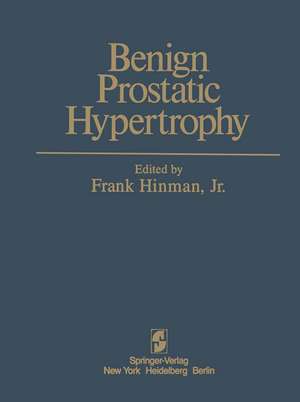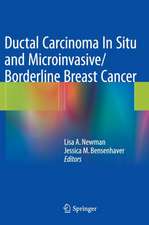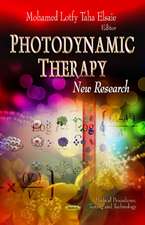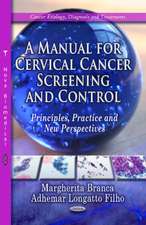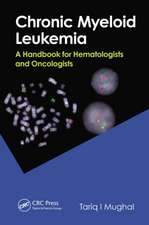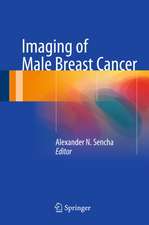Benign Prostatic Hypertrophy
S. Boyarsky F.Jr. Hinman M. Caine, G.D. Chisholm, P.A. Gammelgaard, P.O. Madsen, M.I. Resnick, H.W. Schoenberg, J.E. Susset, NR ZINNERen Limba Engleză Paperback – 4 noi 2011
Preț: 785.30 lei
Preț vechi: 826.62 lei
-5% Nou
Puncte Express: 1178
Preț estimativ în valută:
150.29€ • 156.57$ • 124.96£
150.29€ • 156.57$ • 124.96£
Carte tipărită la comandă
Livrare economică 08-22 februarie 25
Preluare comenzi: 021 569.72.76
Specificații
ISBN-13: 9781461254782
ISBN-10: 1461254787
Pagini: 1128
Ilustrații: XXVIII, 1097 p.
Dimensiuni: 210 x 280 x 59 mm
Greutate: 2.48 kg
Ediția:Softcover reprint of the original 1st ed. 1983
Editura: Springer
Colecția Springer
Locul publicării:New York, NY, United States
ISBN-10: 1461254787
Pagini: 1128
Ilustrații: XXVIII, 1097 p.
Dimensiuni: 210 x 280 x 59 mm
Greutate: 2.48 kg
Ediția:Softcover reprint of the original 1st ed. 1983
Editura: Springer
Colecția Springer
Locul publicării:New York, NY, United States
Public țintă
ResearchDescriere
For more than 60 years, the Californian Family Hinman has exercised a very considerable influence on the development and practice of the highest grade of urology, not only in the American West but worldwide. The leitmotiv of the Hinman School has been honest and thoughtful consideration of the problems of the genitourinary system gone awry. Character is the quintessence of the Hinmans. This virtue distinguishes the present volume on benign pros tatic hypertrophy assembled and edited by Frank Hinman, Jr. I first came under the spell of Frank Hinman, Sr. via his classic studies of renal counterbalance. In brief, in an experimental animal the ureter of one kidney was ligated and the subsequent renal hypertrophy of its contrala teral mate was studied quantitatively from anatomic and functional stand points. There were two central questions in the Hinman study: How does a normal kidney of an experimental animal recognize that its load has been doubled abruptly? What is the signal for renal hypertrophy? Benign hypertrophy of the prostate is quite different from compensatory hypertrophy of the kidney. It is now known that benign prostatic hypertrophy (BPH) is not a hypertrophy but a benign tumor consisting of a collection of spheroids of micro- and macrodimensions. In technical terms BPH is an adenofibromyoma. Perusal of the present volume will reveal many fascinating facets of BPH of particular interest to urologists and others with an investigative bent of BPH does not occur in children. BPH occurs as a medical rarity in mind.
Cuprins
Section I Evolution of Benign Prostatic Hypertrophy and History of Treatment.- 1 Natural History of Benign Prostatic Hypertrophy.- 2 Origins, Distribution, and Risk of Benign Prostatic Hypertrophy.- 3 Interracial Incidence of Benign Prostatic Hypertrophy.- 4 Prostatic Obstruction in Chinese Populations.- 5 History of Nonsurgical Treatment.- 6 Prostatectomy: Past and Present.- 7 Suprapubic Prostatectomy: An Anglo-American Success Story.- Section II Structure and Function.- 8 Surgical Pathology of Benign Prostatic Hyperplasia.- 9 Immunological Aspects of Benign Prostatic Hypertrophy.- 10 Histochemistry.- 11 Stereological Analysis: An Approach to the Pathogenesis of Benign Prostatic Hyperplasia.- 12 Stromal-Epithelial Interaction.- 13 Origins of Benign Prostatic Hypertrophy.- 14 Possible Causative Factors.- 15 Relationship of the Origin of Benign Prostatic Hypertrophy to Prostatic Structure of Man and Other Mammals.- 16 The Relationship Between Benign Prostatic Hyperplasia and Prostatic Carcinoma.- Section III Endocrine Control.- 17 Endocrine and Cellular Inductive Factors in the Development of Human Benign Prostatic Hypertrophy.- 18 Cellular Growth and Hormone Receptors.- 19 Current Models and Their Relation to Human Disease.- 20 Effects of Castration, Estrogen, and Androgen Administration.- 21 Androgen Levels and Binding in Benign Prostatic Hyperplasia.- 22 Laboratory Evidence of Endocrine Effects.- 23 Effect of Hormones on Established Prostatic Hypertrophy.- 24 Human Trials of Endocrine Management.- 25 Treatment with Cyproterone Acetate and/or Bromocriptine.- 26 Megesterol Acetate in Treatment.- 27 Effect of Cholesterol-lowering Agents.- 28 Assessment of Medical Treatment.- 29 Directions for Future Research.- Section IV Neurophysiology of Obstruction.- 30 Coordination in Bladder Function.- 31 Autonomic Muscular Innervation of the Vesical Outlet and Its Role in Micturition.- 32 Autonomic Innervation of the Prostate.- 33 Urethrovesical Reflexes and Their Inhibition.- 34 Mechanisms of Autonomic Drug Action on the Bladder Outlet.- 35 Effect of Nonautonomic Drugs on the Vesical Neck.- 36 Pharmacological Receptors in the Prostate.- 37 Changes in Adrenergic Receptors in Bladder Outlet Obstruction.- 38 Principles for Evaluation of Pharmacologic Agents.- 39 Pharmacological Management of Outlet Obstruction.- 40 Prospects for Pharmacologic Management.- Section V Urodynamic Evaluation of Obstruction.- 41 The Physical Basis of Obstructive Uropathy.- 42 Detrusor Energy Factors.- 43 Detrusor as the Energy Source of Micturition.- 44 The Contribution of the Bladder Outlet to the Relation Between Pressure and Flow Rate During Micturition.- 45 Dynamics of Acute Retention.- 46 Clinical Significance of Urodynamic Measurements.- 47 Hydrodynamic Significance of Flow Rate Determination.- 48 Urinary Flow Rates: Measurement and Adjustment.- 49 Development of Nomograms for Application of Uroflowmetry.- 50 Urinary Velocity in Prostatism.- 51 The Video-Audio Voiding Cystourethrogram and Synchronous Pressure-Flow Cystourethrography.- 52 High-flow High-pressure Obstruction.- 53 The Urinary Drop Spectrometer in Diagnosis.- 54 Information Content of Urodynamics.- 55 Urethral Pressure Profiles.- 56 Urethral Static Pressure Profile.- 57 Residual Urine: Measurement and Influence on Management of Obstruction.- 58 Correlation of Flow Rate and Residual Urine with Symptomatology.- 59 Ultrasound Evaluation of Prostatic Size and Residual Urine.- 60 Use of the Intravenous Urogram in Diagnosis.- 61 The Intravenous Urodynamogram.- 62 Relationship Between Clinical Urodynamics and Pathologic Findings in Prostatic Obstruction.- 63 Urodynamic Interpretation of Symptoms.- 64 Future Prospects for Urodynamic Study in Clinical Evaluation of Benign Prostatic Hypertrophy.- Section VI Local Effects of Obstruction.- 65 Effects of Aging and Prostatic Obstruction on Detrusor Morphology and Function.- 66 Detrusor Morphology in Relation to Bladder Outflow Obstruction and Instability.- 67 Surgical Anatomy of the Prostatic Lobes.- 68 Relation of Prostatic Lobes to Degree and Rate of Obstruction.- 69 The Development of Vesical Trabeculation.- Section VII Secondary Effects of Obstruction.- 70 Sequential Events in Prostatic Obstruction.- 71 The Symptoms of Bladder Outlet Obstruction: Detrusor Dysfunction and the Myth of “Prostatism”.- 72 Obstruction and the Uninhibitable Detrusor.- 73 Progression of Obstruction and Symptoms.- 74 Diseases Complicating Management of Benign Prostatic Hypertrophy.- 75 Bacterial Prostatitis and Benign Prostatic Hypertrophy.- 76 Infection and Stasis.- 77 Effect of Obstruction on Renal Function.- Section VIII Indications for Operation.- 78 Differential Diagnosis.- 79 A Point System for Selecting Operative Candidates.- 80 Prostatic Health Status Index.- 81 Indications for Prostatectomy—Mandatory and Optional.- 82 Prostatectomy in Vesical Neurological Disturbances.- 83 Role of Self-Catheterization in Prostatism.- 84 Distention Therapy in Early Stages.- Section IX Surgical Treatment.- 85 The Anatomical Objectives of Operation.- 86 Selection of Operations.- 87 The Sphincter Mechanisms: Their Relation to Prostatic Enlargement and Its Treatment.- 88 Transurethral Prostatectomy.- 89 Internal Urethrotomy.- 90 Water Intoxication.- 91 Risk Management Program in Electrosurgery.- 92 Perioperative Antibiotics.- 93 Consequences of Incomplete Prostatic Transurethral Resection.- 94 Suprapubic Prostatectomy.- 95 Simple (Conservative) Perineal Prostatectomy.- 96 Retropubic Prostatectomy.- 97 Reconstructive Posterior Prostatectomy.- 98 Cryosurgical Treatment.- Section X Results of Surgery.- 99 Psychosexual Counseling: Informed Consent.- 100 Urodynamic Results of Surgery.- 101 Evaluation and Management of Symptoms After Prostatectomy.- 102 Late Results and Complications of Prostatectomy.- 103 Postprostatectomy Strictures.- 104 Postprostatectomy Incontinence: Urodynamic Evaluation.- 105 Postprostatectomy Incontinence: Surgical Repair—Bladder Neck Reconstruction.- 106 Postprostatectomy Incontinence: The Artificial Sphincter.- 107 Effect of Benign Prostatic Hypertrophy and Consequent Operations on Potency.- 108 A Method for Establishing Fees.- 109 Future of Surgery for Prostatic Hypertrophy.- Section XI Annotated Bibliography.- I Evolution of Benign Prostatic Hypertrophy and History of Treatment.- II Structure and Function.- III Endocrine Control.- IV Neurophysiology of Obstruction.- V Urodynamic Evaluation of Obstruction.- VI Local Effects of Obstruction.- VII Secondary Effects of Obstruction.- VIII Indications for Operation.- IX Surgical Treatment.- X Results of Surgery.
